Many websites struggle to convert visitors into paying customers.
A beautiful design and persuasive copy alone often aren’t enough. The real hurdle? Lack of trust.
Users landing on a site for the first time are naturally skeptical; they need assurance that your offer is credible.
Without trust signals, even the best offers fall flat.
This is where testimonials come in.
Genuine customer feedback taps into the power of social proof, giving new visitors the confidence to take action.
Whether you’re offering services, digital products, or consultations, testimonials validate your promises through the voices of happy clients.
On websites, testimonials aren’t just decorative; they’re strategic tools that can drastically shift visitor perception and drive more conversions.
This blog will guide you through the why, how, and where of integrating testimonials on your website, using WiserNotify, a powerful tool for adding dynamic testimonial notifications and widgets.
Why Add Testimonials to Websites?
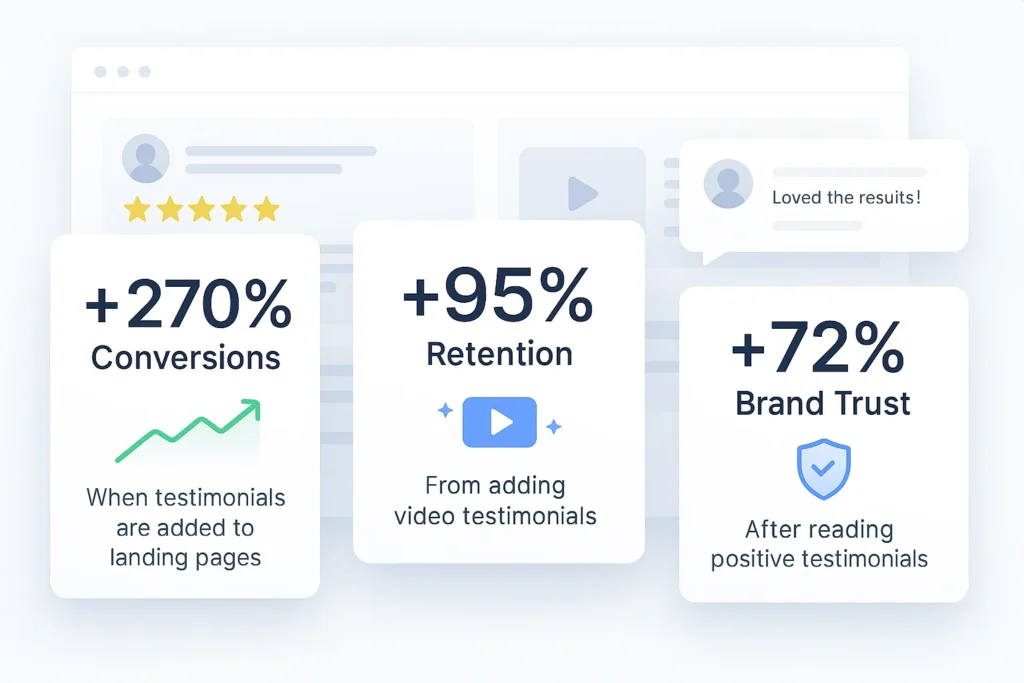
Trust is the cornerstone of every successful online interaction.
Testimonials bridge the gap between visitor skepticism and conversion readiness.
On websites, they serve a unique function—offering social validation without requiring users to dig for it.
When visitors land on your homepage, they subconsciously ask, “Can I trust this brand?” Testimonials instantly answer that question.
According to WiserNotify’s 2025 data, 72% of customers trust a brand more after reading positive testimonials, and websites displaying testimonials have seen up to a 270% increase in conversions.
The benefits are not just psychological but quantifiable. Video testimonials increase retention rates by 95%, and testimonial videos on landing pages can boost conversions by 80%.
This makes them more impactful than almost any other form of content.
Testimonials improve more than just conversions. They:
Improve SEO by increasing dwell time and keyword relevance when embedded with structured data.
Drive higher engagement by reinforcing claims made throughout the site.
Reduce bounce rates by offering proof of value early in the user journey.
Consider a service-based business, such as a fitness coach offering virtual training programs.
When visitors see a testimonial like “I lost 10 pounds in 6 weeks with Lisa’s plan” right below the program description, it instantly validates the offer and builds trust.
Using WiserNotify, these testimonials become dynamic.
You can display real-time reviews, star ratings, and location-based notifications, such as “Mark from Austin just left a 5-star review.”
These micro-trust nudges dramatically boost credibility.
How to Add Testimonials to Websites
Now let’s get into how to embed a testimonial on your site or store, whether it’s text, photo, or video.
First, sign up for WiserReview. There is a free plan if you are just starting, but there are also upgrades available for SMBs and enterprise businesses.
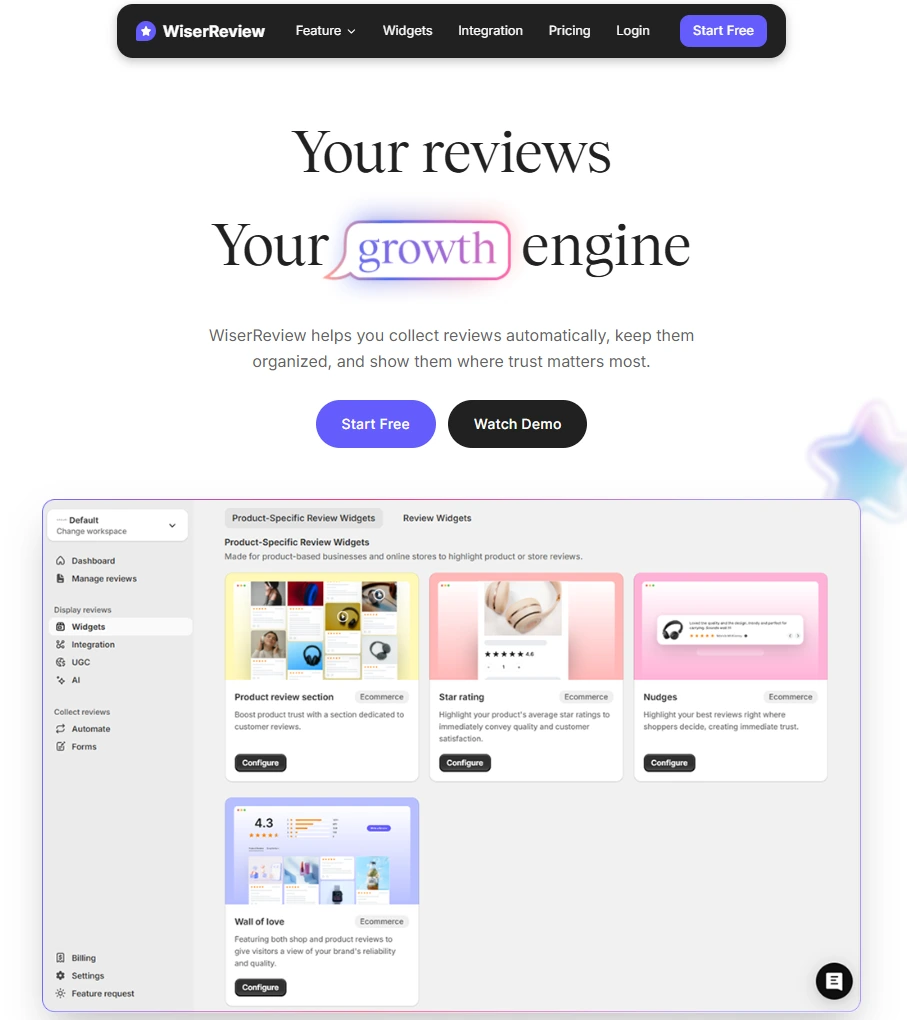
Once you sign up for your account, you can see the WiserReview dashboard.
This dashboard is your control center, where you can manage all aspects of your testimonial management. It provides a clear overview of your testimonial collection, moderation, and display processes.
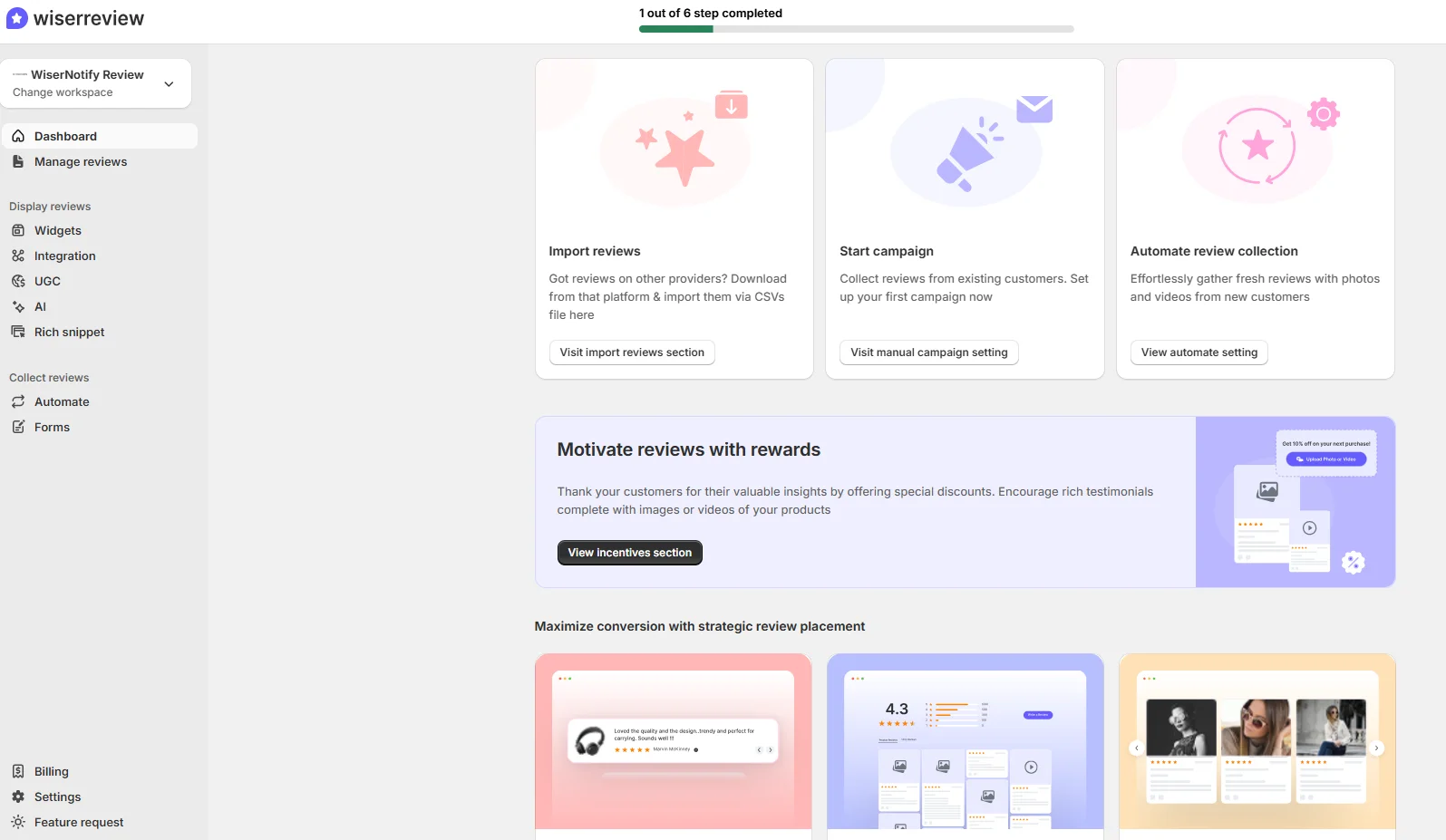
Don’t be overwhelmed. WiserReview is a comprehensive testimonial management software that not only helps you add testimonials but also collects and moderates them.
And the best part? It’s designed to be user-friendly, so you’ll find it easy to navigate and use.
From the dashboard:
Go to → Manage reviews section and click on the “Import” button.
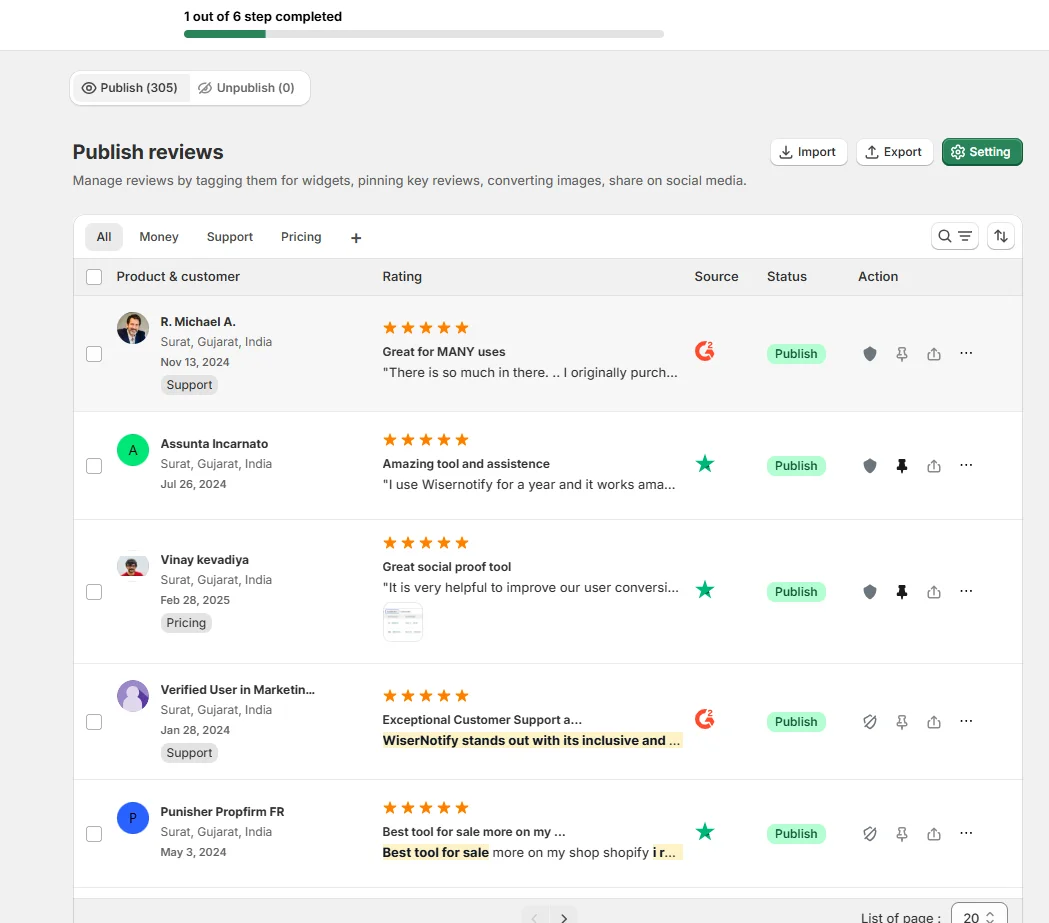
From there, you have many options to import testimonials from; select any of them.
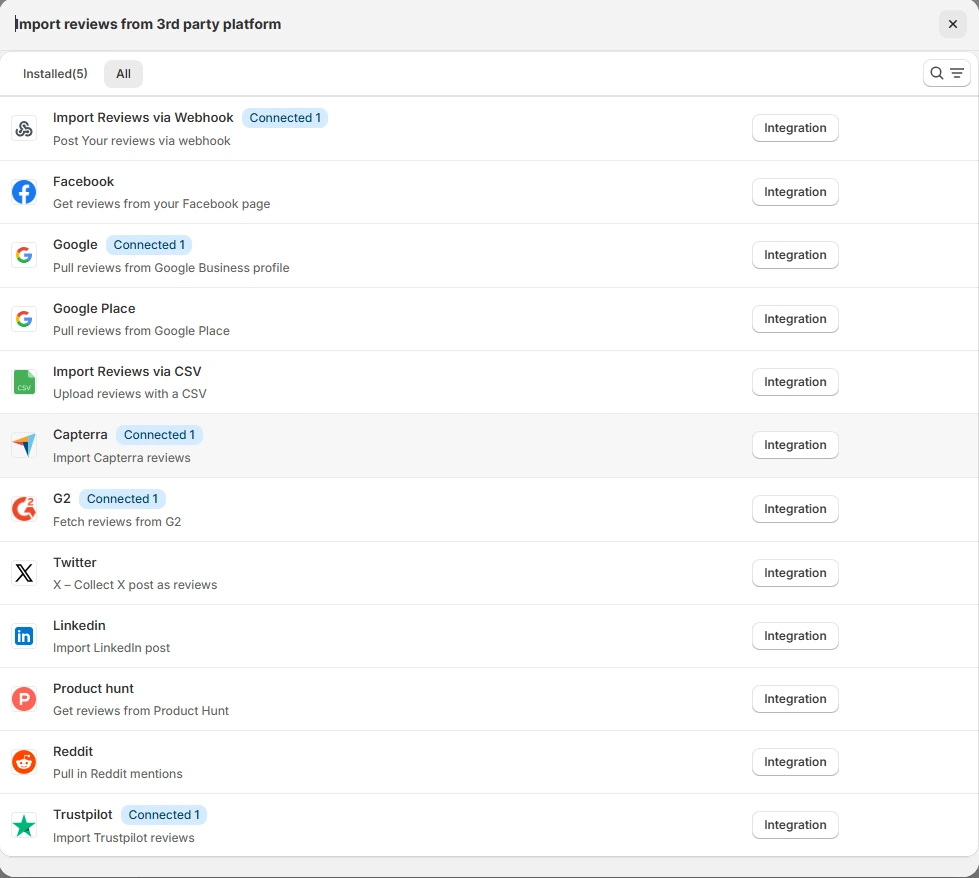
Once done, you have a testimonial showing in the manage reviews section.
Now let’s go to the “Widget” section.
Here, you have a wide range of widgets to choose from. Simply click on “configure” for any widget you need.
Each one is designed to build trust, credibility, and drive more conversions and sales through immediate consumer decision-making.

For example, we chose the “Review wall” widget for our second product.
This widget displays a dynamic wall of your testimonials, creating a visually appealing and trustworthy display for your potential customers. And yes, we use Wiserreview’s testimonial widget for this purpose.
Once you click on configure, you can see the widget customization dashboard. In it, click on “Filter”.
In it, select the Review source.

Now your testimonial appears on the widget, and you can easily customize the widget to match your brand’s style.
It’s a straightforward process, and we’re confident you’ll find it intuitive and user-friendly.
Now, once it’s done, click on “Install” and choose from any of the three options.
- JavaScript – Insert this script where you want the testimonial widget to appear on your website.
- Iframe – Use this iframe code to embed the testimonial widget in a specific section of your site.
- URL – Share this URL to display the testimonial widget on a separate page.
Now the widget is live and ready to build trust and drive conversions.
We are also using this on our site, WiserReview, and Wisernotify.
Here is an example of it:

And wait, that’s just the tip of the iceberg of what Wiserreview can do for testimonial management.
WiserReview can:
Automated testimonial collection
Create a smart testimonial form with the following setup:
- Set up your testimonial submission link.
- Add buttons for easy interaction.
Display a star rating or feedback question on the first screen to assess intent. If the feedback is low, prompt for detailed comments. If the feedback is positive, direct the user to submit their testimonial.
WiserReview simplifies the process of requesting testimonials, automating personalized requests via email, SMS, or other messaging channels, making it easier for businesses to collect testimonials.
Integrate the testimonial form link with your existing POS, email, and SMS systems.
You can also post new sales data to the WiserNotify webhook API to automate the process. This streamlines testimonial requests and enhances customer engagement through your existing channels.
Centralized Testimonial Management

Testimonial Aggregation: WiserReview aggregates testimonials from various platforms (emails, forms, social, etc.), bringing them into one central dashboard. This helps businesses track their testimonials and gain real-time insights.
Testimonial Monitoring: The platform notifies businesses whenever a new testimonial is submitted, allowing them to stay up-to-date with feedback.
AI reply: WiserReview helps businesses respond to customer testimonials automatically with AI.
AI-powered testimonial display and sharing

- Automatically select positive sentiment testimonials.
- Publish them live on your site.
- Convert these testimonials into graphics and post them on your social media channels.
This enhances customer trust and promotes positive feedback across platforms.
Embed Testimonials on Websites
Embedding testimonials on your website using WiserNotify is straightforward and doesn’t require advanced technical skills.
Begin by signing in to your WiserNotify dashboard and follow these steps:
Start by installing the WiserNotify pixel. Copy the unique pixel code from your WiserNotify account and paste it into the section of your website’s HTML.
This will activate the tracking and enable the display of testimonial widgets.
Once the pixel is active, go to the “Notifications” tab and click on “Create Notification.” Choose from testimonial display types like review pop-ups, carousel sliders, or static widgets.
Customize the content to match your brand. You can change colors, fonts, icons, and layout. To improve authenticity, include real-time data like customer names, cities, and review highlights.
Set display rules to define where the testimonials will appear—on the homepage, product pages, or thank-you screens.
Use targeting options like URL conditions, visitor type (new/returning), and time spent on page.
Finally, test and publish. Preview the testimonials on your site to ensure they match the flow and aesthetics.
WiserNotify also provides analytics, allowing you to A/B test different testimonial styles and placements to see what drives the most engagement.
If your testimonials aren’t displaying, double-check that the pixel code is correctly installed and that the notification is set to active.
Also, ensure there are no JavaScript conflicts with other plugins or themes.
With WiserNotify, integrating testimonials becomes a low-effort, high-impact strategy.
Related: How to build a review page on a website that looks great
3 Testimonial Optimization Tips
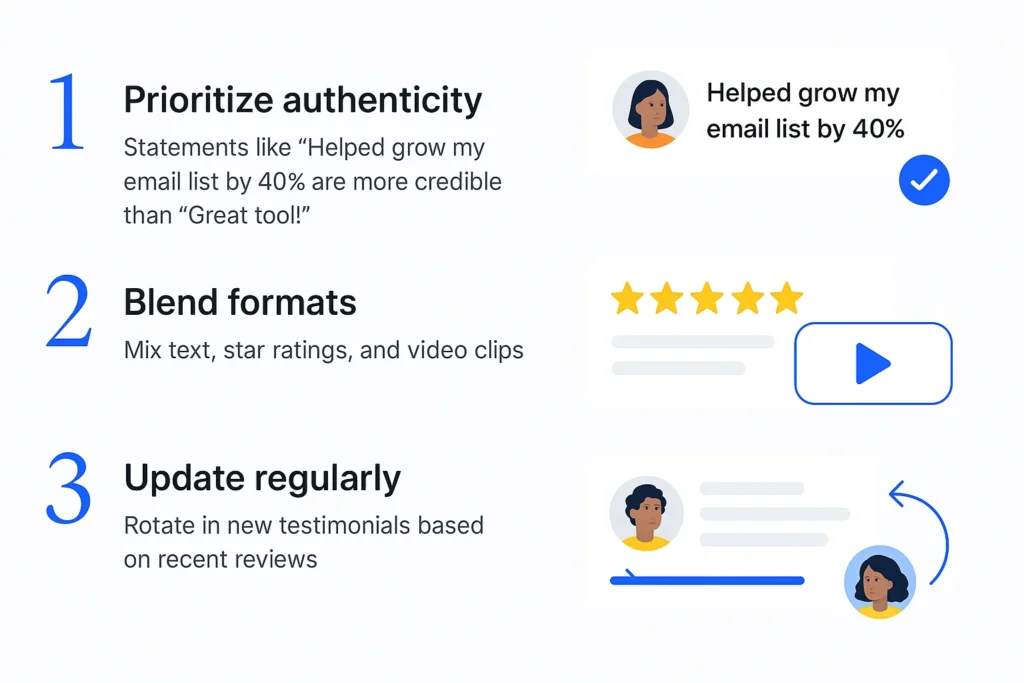
Now, look at some of the best testimonial optimization tips to help you use testimonials and reviews effectively.
1. First, always prioritize authenticity.
Users can sense stock images and vague praise a mile away. Opt for testimonials that mention specific benefits, use cases, or results.
Statements like “Helped grow my email list by 40%” are far more credible than “Great tool!”
2. Second, blend format variety.
Mix text-based testimonials with star ratings and video clips. This keeps your presentation engaging and caters to different user preferences.
Some may skim, while others prefer watching or seeing ratings.
3. Third, update your testimonials regularly.
Stale feedback gives the impression of inactivity. Use WiserNotify’s dynamic feed options to rotate new testimonials based on the latest customer reviews.
This ensures your social proof stays fresh and relevant.
These minor tweaks can result in significant improvements in conversion and engagement rates.
Best Places to Show Testimonials on Websites

The placement of testimonials significantly impacts their effectiveness.
Thoughtful positioning not only boosts visibility but also amplifies credibility and timing.
Here’s how you can strategically place testimonials across your website.
1. Homepage
Your homepage is your brand’s digital storefront. Featuring testimonials here immediately builds trust with first-time visitors.
Place them below the hero section or right after your core value proposition.
This sequence creates a trust ladder: introduction > value > proof.
2. Product or Service Pages
This is where decision-making peaks. A testimonial showcasing how a product solved a specific problem reassures hesitant buyers.
Embed testimonials next to product features or service descriptions.
For instance, a web design agency could feature client feedback beside portfolio samples.
3. Landing Pages
Landing pages thrive on focus and clarity. Including a compelling testimonial near the call-to-action (CTA) can make the difference between a bounce and a conversion.
WiserNotify allows you to use dynamic popups, such as “32 people signed up in the last 24 hours.”
4. Checkout Pages
Last-minute doubts often creep in during checkout. Reassure users with brief, high-impact testimonials next to the payment form.
It’s the final nudge many need. Think, “I was hesitant, but this was worth every penny—John D.”
5. About Page
The About page tells your story—add customer voices to improve it. Visitors learning about your journey alongside customer experiences deepens the connection and trust.
6. Blog Pages
If you run an active blog, testimonials at the end of articles can drive users to explore your services.
A testimonial slider here acts as a subtle yet powerful exit-intent strategy.
7. Dedicated Testimonial Page
Finally, compile all testimonials on a single page. This becomes a go-to trust anchor, especially for skeptical visitors. WiserNotify supports creating testimonial walls that auto-update with fresh reviews.
Clever placement turns testimonials into conversion catalysts.
With WiserNotify, displaying them where they matter most becomes seamless.
Other Ways to Add Testimonials to Websites
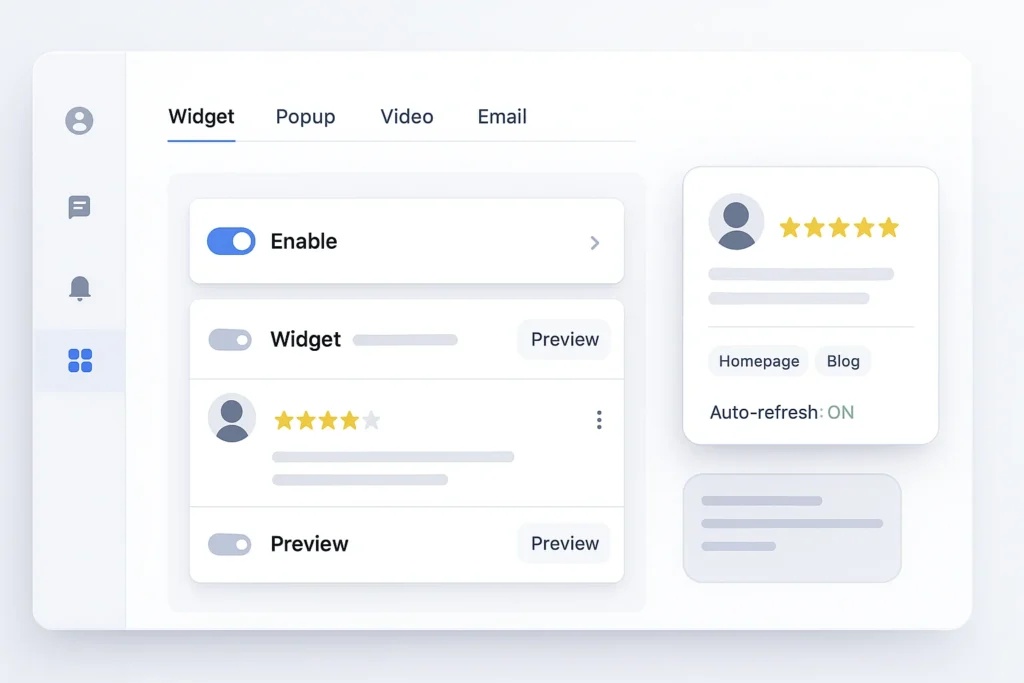
Static testimonial sections are powerful, but modern websites can benefit from more dynamic integrations.
Here are some advanced methods to feature testimonials using WiserNotify:
1. Dynamic Review Widgets
Use WiserNotify’s real-time widgets to show recent reviews with customer names, star ratings, and locations.
These can be placed as floating elements or embedded within sections. Visitors feel the “buzz,” making your site look lively and trusted.
2. Carousel Sliders
Carousel sliders are great for showcasing multiple testimonials without overwhelming the layout.
WiserNotify lets you design custom sliders that fit neatly into sections like your homepage, blog, or pricing page. Add photos, names, and timestamps for maximum authenticity.
3. Video Testimonials
Video is unmatched for emotional impact. WiserNotify allows integration of video reviews that autoplay silently with captions.
These can be embedded in hero sections or dedicated testimonial galleries. A video saying “This tool saved my business” carries immense weight.
4. Social Proof Popups
Turn testimonials into social proof alerts. Notifications like “Just now: Priya left a 5-star review” create FOMO and urgency.
These popups can be geo-targeted, adding an extra layer of personalization. WiserNotify excels at configuring and displaying these on scroll or with time delays.
5. Exit-Intent Testimonial Prompts
Catch abandoning visitors with a last-minute testimonial popup.
As the user moves toward the close button, show a review that reassures them to stay or convert. It’s subtle yet powerful.
6. Thank You Pages
After a user converts, reinforce their decision with testimonials. This post-conversion reinforcement reduces buyer’s remorse and boosts referral likelihood.
WiserNotify makes this easy by letting you control where and when these testimonials show.
7. Email Testimonials
Though off-site, emails can carry WiserNotify testimonial widgets too. Embed them in newsletters or drip campaigns to reinforce trust continuously.
All these methods are manageable from the WiserNotify dashboard. You can design, schedule, and test every element without touching your codebase.
3 Testimonial Mistakes on Websites

While testimonials are powerful, poor execution can harm more than help.
Here are three critical mistakes website owners make:
1. Using Generic Praise
Statements like “Great service” or “Loved it” are too vague to be convincing. They lack context and don’t speak to the specific benefits of your offering.
Instead, aim for testimonials that highlight measurable outcomes or detailed experiences.
For instance, “This SEO tool increased my organic traffic by 52% in three months” tells a compelling story.
2. Overloading Pages with Reviews
More isn’t always better. Displaying too many testimonials, especially without visual breaks, can overwhelm users and dilute impact.
Prioritize quality over quantity. Use WiserNotify to rotate or trigger testimonials based on scroll depth or visitor behavior.
This keeps the experience personalized and digestible.
3. Not Optimizing for Mobile
Many websites overlook how testimonials render on smaller screens. Misaligned carousels, oversized fonts, or cut-off videos can ruin the experience.
Always preview your testimonial displays on mobile devices. WiserNotify provides responsive design options to ensure seamless integration across devices.
Avoiding these pitfalls ensures your testimonials perform as intended—as conversion catalysts, not clutter.
Wrap Up
Testimonials aren’t just feel-good feedback—they’re high-converting, trust-building assets that every website should leverage.
Whether you run a consultancy, sell digital products, or operate an agency, strategically placed testimonials can dramatically boost your credibility and conversions.
With tools like WiserNotify, displaying testimonials becomes effortless and optimized.
From homepage sliders to real-time pop-up reviews, you can tailor testimonial experiences that align perfectly with your brand and audience.
Now is the time to transform your website into a trust machine. Start by installing WiserNotify, curating authentic customer voices, and showcasing them where they matter most.
When your visitors see proof, they start to believe—and buy.
Related post:
How to embed testimonials on wordpress
How to add testimonials on Squarespace
How to embed testimonials on Webflow
How to embed testimonials on Shopify
How to embed testimonials on a Carrd




